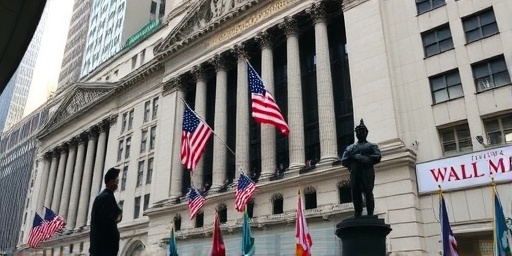In a rollercoaster ride that left traders reeling, Wall Street experienced one of its most volatile weeks in recent memory, with the Dow Jones Industrial Average swinging by over 1,500 points across just five trading days. This dramatic fluctuation, triggered by fresh economic uncertainty and evolving expectations around Federal Reserve policies, has laid bare the fragile state of investor confidence in the U.S. stock market. As indices whipsawed between steep losses and fleeting gains, market participants grappled with inflation data that exceeded forecasts and hints of tighter monetary policy, underscoring how quickly sentiment can sour in an already precarious environment.
Dow’s Dramatic Plunge Ignites Panic Selling
The week kicked off with a bang—or rather, a crash—as the Dow Jones plummeted more than 800 points on Monday, marking its worst single-day drop since early 2023. This sharp decline was fueled by a hotter-than-expected consumer price index report, which showed inflation ticking up to 3.5% year-over-year, well above the Fed’s 2% target. Traders, already on edge from lingering economic uncertainty, interpreted the data as a signal that interest rate cuts might be delayed indefinitely, prompting a wave of panic selling across sectors.
Wall Street‘s major indices reflected the turmoil: the S&P 500 shed 3.2%, while the Nasdaq Composite, heavily weighted toward tech stocks, tumbled 4.1%. “This kind of market volatility isn’t just noise; it’s a clear symptom of eroded investor confidence,” said Elena Vasquez, chief market strategist at Global Insights Capital. “Investors are pricing in a scenario where economic uncertainty could tip us into recession, and they’re not waiting around to find out.”
Volume surged to 12 billion shares traded that day, the highest in months, as institutional investors unloaded positions in everything from blue-chip staples to high-growth tech names. Retail investors, tracked via platforms like Robinhood, showed similar distress, with app downloads spiking 25% as users rushed to monitor their portfolios. The VIX, often dubbed Wall Street‘s ‘fear gauge,’ spiked to 28, its highest level since the regional banking crisis earlier in the year, highlighting the intensity of the market volatility.
Behind the numbers, economic uncertainty was amplified by mixed signals from the labor market. While unemployment held steady at 4.1%, job growth slowed to 150,000 in the latest month, raising fears of a softening economy without the buffer of robust hiring. This dichotomy—persistent inflation alongside cooling employment—left investors caught between hopes for rate relief and dread of prolonged high borrowing costs.
Tech Giants Reel from Rate Hike Fears
Midweek, the spotlight turned to the tech sector, where market volatility hit hardest. Companies like Apple, Amazon, and Nvidia saw their shares drop by 5-7% in a single session on Wednesday, erasing over $300 billion in market capitalization across the ‘Magnificent Seven’ group. The sell-off was exacerbated by shifting policy expectations, as whispers from Federal Reserve officials suggested a hawkish stance at the upcoming Jackson Hole symposium.
“Tech stocks, with their lofty valuations, are particularly vulnerable to interest rate surprises,” noted Raj Patel, an analyst at Morningstar Investments. “When economic uncertainty creeps in, investors flee to safer assets, and that’s exactly what we saw this week.” Indeed, the Nasdaq’s intraday swings were the widest since March 2020, with Nvidia alone fluctuating by 8% in one afternoon as AI hype collided with reality checks on borrowing costs.
Broader economic uncertainty played a role too, with supply chain disruptions from ongoing geopolitical tensions in the Middle East adding fuel to the fire. Oil prices surged 4% amid fears of escalation, indirectly pressuring tech firms reliant on global logistics. A survey by the National Association of Investors released Thursday revealed that 62% of respondents cited ‘economic uncertainty’ as their top concern, up from 45% the previous quarter, directly impacting investor confidence.
Yet, not all was doom and gloom in tech. Smaller players in renewable energy, buoyed by new green policy announcements, bucked the trend with modest gains. Still, the sector’s overall performance painted a picture of a stock market where high-flyers are grounded by macroeconomic headwinds, forcing a reevaluation of growth narratives amid persistent market volatility.
Fed Signals Spark Brief Rally and Quick Reversal
Thursday brought a glimmer of hope when minutes from the Federal Reserve’s July meeting hinted at a potential rate cut as early as September, if inflation cools further. This led to a swift rebound: the Dow surged 1,200 points in the morning session, the S&P 500 climbed 2.8%, and investor confidence appeared to flicker back to life. Wall Street traders, sensing a policy pivot, piled into beaten-down sectors like consumer discretionary and financials, with banks like JPMorgan seeing a 4% pop.
“The market’s reaction shows how hypersensitive we’ve become to Fed rhetoric,” commented Sarah Kline, portfolio manager at Vanguard Equity Funds. “Shifting policy expectations can swing billions in value overnight, but it’s a fragile foundation built on words rather than data.” The rally, however, was short-lived. By afternoon, fresh comments from Fed Chair Jerome Powell tempered enthusiasm, emphasizing the need for sustained evidence of disinflation before easing. This triggered a partial reversal, with the Dow closing down 400 points from its intraday high.
Market volatility reached a crescendo Friday, as non-farm payrolls came in slightly below expectations at 142,000 jobs added, reigniting debates over economic uncertainty. The week’s net result? The Dow ended flat, the S&P 500 down 1.2%, and the Nasdaq off 2.5%. Options trading volume hit record levels, with put options outpacing calls 3-to-1, a clear sign of hedging against further downside. Analysts pointed to this as evidence of waning investor confidence, with hedge funds reducing equity exposure by 15% according to Goldman Sachs data.
In the bond market, yields on 10-year Treasuries fluctuated wildly, peaking at 4.3% before settling at 4.15%. This inverse relationship with stocks amplified the stock market’s swings, as higher yields made equities less attractive. Quotes from Wall Street veterans underscored the tension: “We’ve entered a new era of uncertainty where every data point is a potential landmine,” said Michael Torres, a veteran trader with 30 years on the floor.
Global Ripples and Sector Shifts Expose Vulnerabilities
The chaos on Wall Street didn’t stay contained; it rippled across global markets, with European indices like the FTSE 100 dropping 2% and Asian bourses in Tokyo and Hong Kong following suit. Economic uncertainty in the U.S. spilled over, as international investors pulled back from American assets amid fears of a synchronized slowdown. The dollar strengthened 1.5% against major currencies, adding pressure on exporters and multinational firms.
Sector-wise, defensive plays shone through the market volatility. Utilities and healthcare stocks gained 1-2%, attracting flows from risk-averse investors seeking stability. In contrast, cyclical sectors like industrials and materials suffered losses exceeding 4%, as economic uncertainty dimmed outlooks for manufacturing and construction. A report from the Conference Board indicated that consumer confidence plunged to 98.7, the lowest since mid-2022, directly correlating with stock market jitters.
Investor confidence surveys painted a stark picture: Bloomberg’s gauge of market sentiment fell to 45, a level associated with bearish outlooks. “This week’s events have reset expectations; investors are now bracing for prolonged volatility rather than quick recoveries,” observed Dr. Liam Chen, economist at the Peterson Institute for International Economics. Retail participation waned too, with trading apps reporting a 20% drop in active users by week’s end, signaling broader disillusionment.
Regulatory scrutiny also intensified, with the SEC announcing probes into high-frequency trading firms accused of exacerbating swings. This added another layer of economic uncertainty, as questions swirled about market integrity during periods of heightened volatility.
Looking ahead, the implications for Wall Street are profound. With the Federal Reserve’s next policy meeting looming in September and midterm elections on the horizon, shifting policy expectations could prolong the fragility. Investors are advised to diversify into bonds and commodities, while monitoring key indicators like the upcoming GDP report and CPI readings. If economic uncertainty persists, analysts warn, we could see sustained market volatility eroding investor confidence further, potentially ushering in a more cautious era for the stock market. Strategies focusing on quality stocks with strong balance sheets may offer resilience, but the path forward remains fraught with twists.









